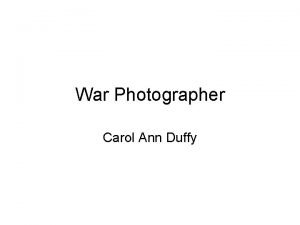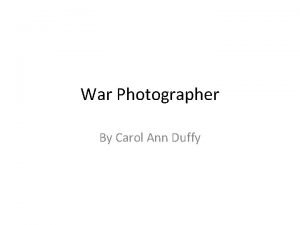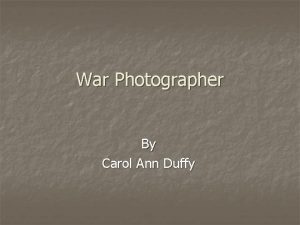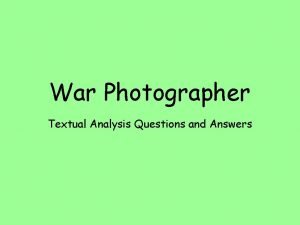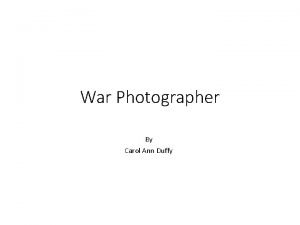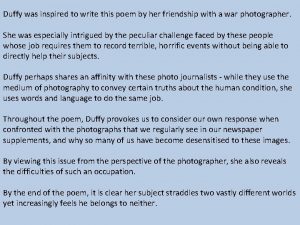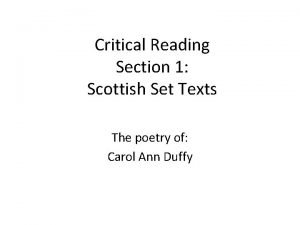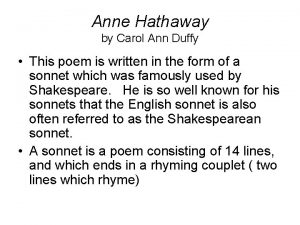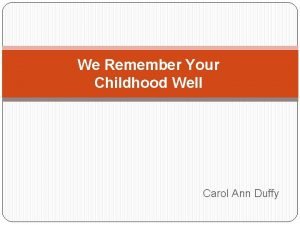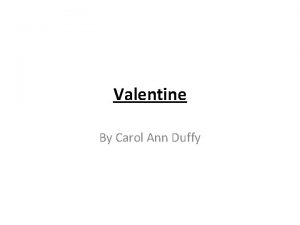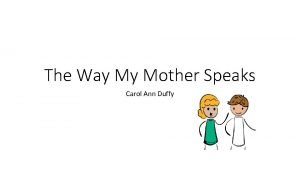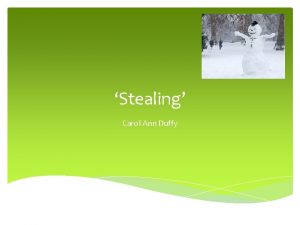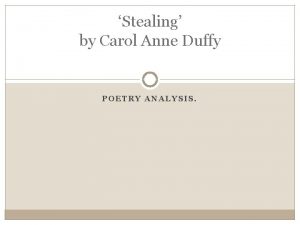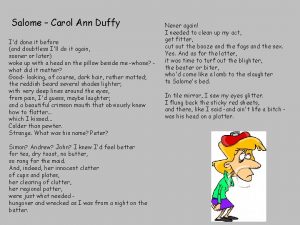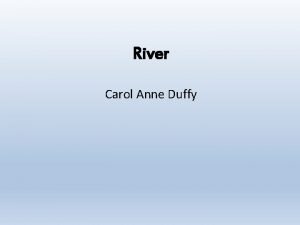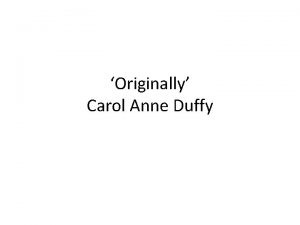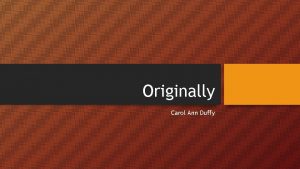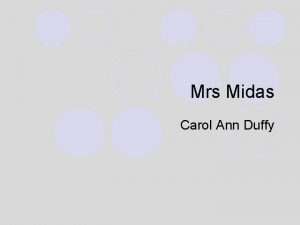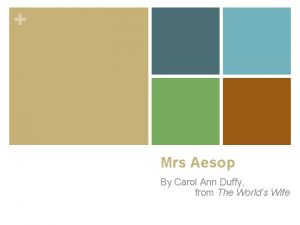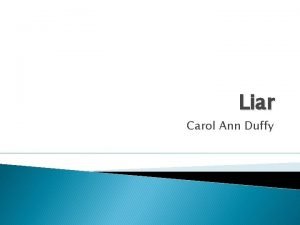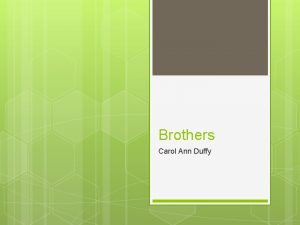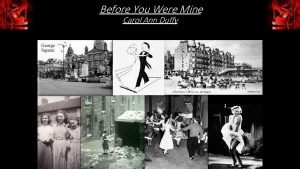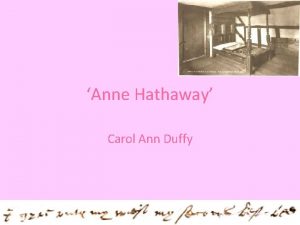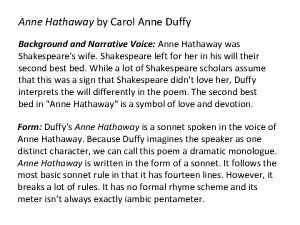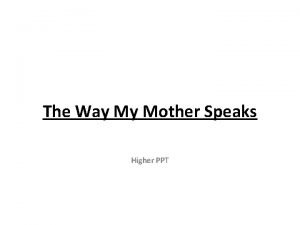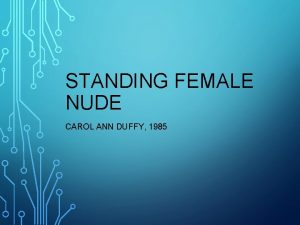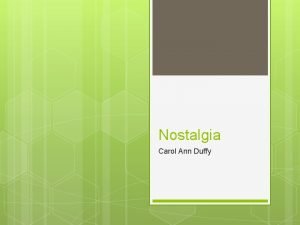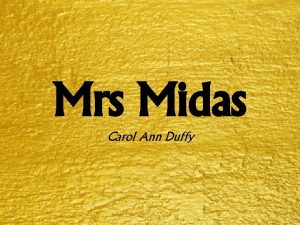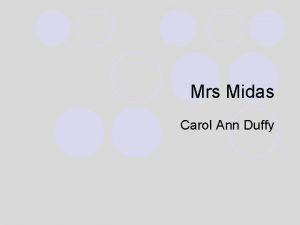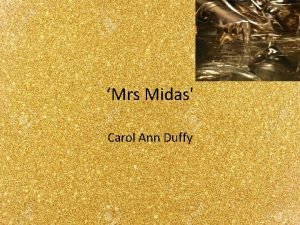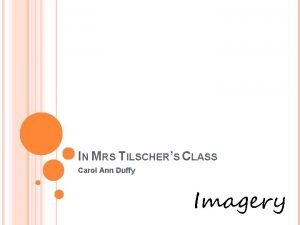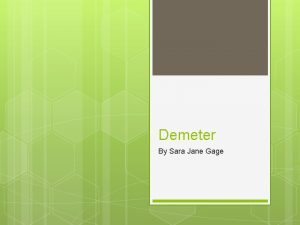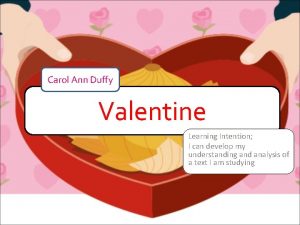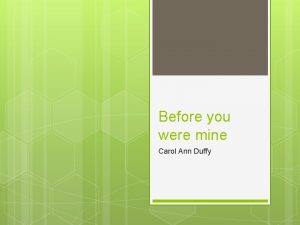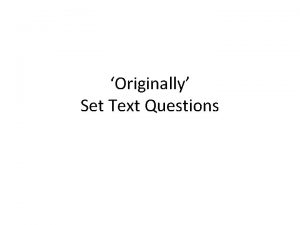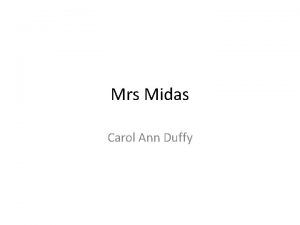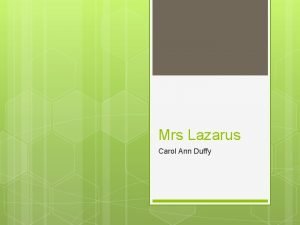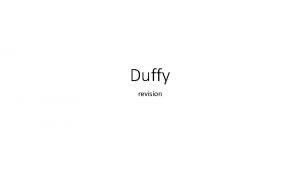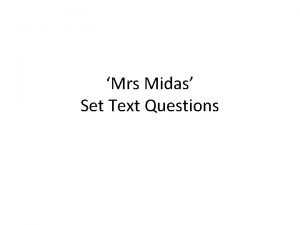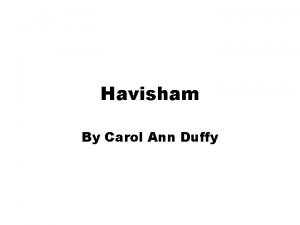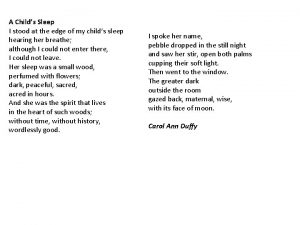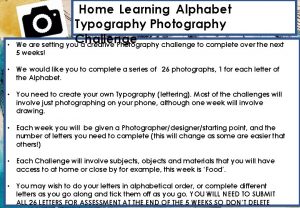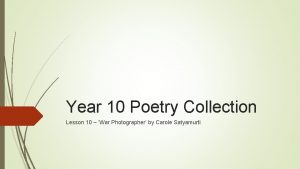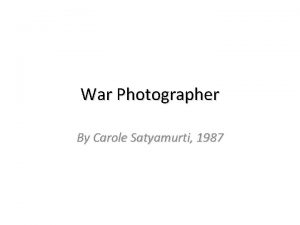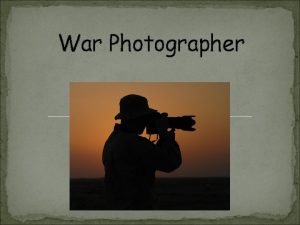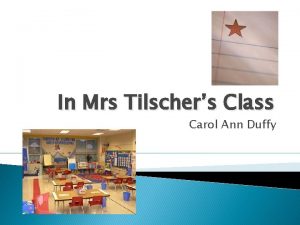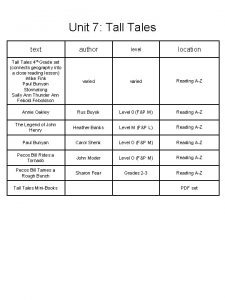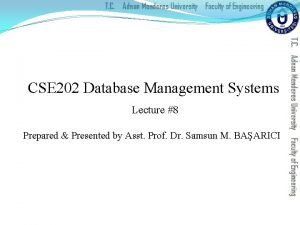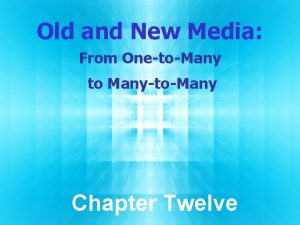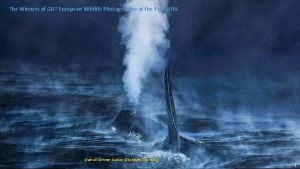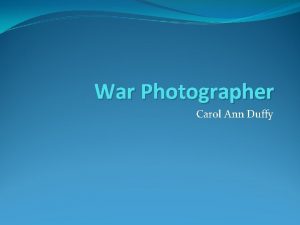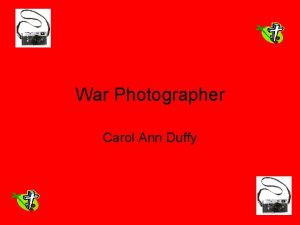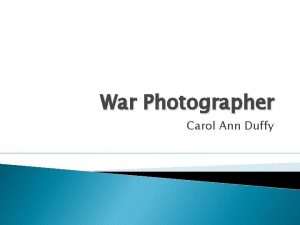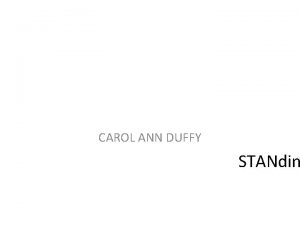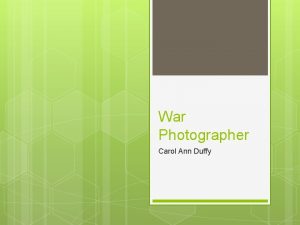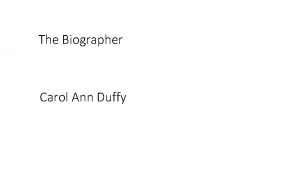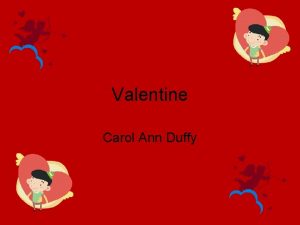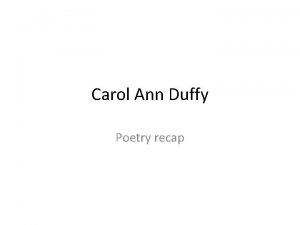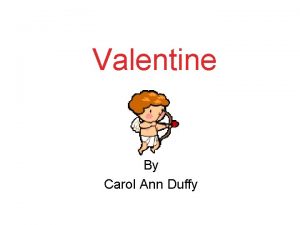War Photographer Carol Ann Duffy Many war photographers











































































- Slides: 75

War Photographer Carol Ann Duffy

Many war photographers claim that they are capturing something which might not be seen by the public otherwise. They risk their lives so that we see what is really happening in the world. Or do they? Is it right that they can sit by and photograph as people are killed in front of them?

“War photographers are accused of being adrenaline junkies. Continually on the hunt for the next war, the next picture, they shove their lenses into the faces of their traumatized victims. ” “The war (photographers) also experienced a rate of Post Traumatic Stress Disorder over the course of their lives that far exceeded that of firefighters and police officers. In fact, war journalists approximated the PTSD rate recorded in combat veterans. ”

What kind of person… n. Will go somewhere dangerous and life- threatening, knowing they might die? n Will purposefully do a job that could kill them? n Is a war photographer?


This picture shows the potential power of still photographic images from the Vietnam war. When the American president saw this picture he decided there and then to end the war.


“War Photographer” by Carol Ann Duffy The poem comes from Duffy’s friendship with Don Mc. Cullin and Philip Jones Griffiths, two well-respected photographers who specialised in war photography. Duffy is fascinated by what makes someone do such a job and how they feel about being in situations where a choice often has to be made between recording horrific events, and helping.

• This poem is about a person who is clearly not the poet. • The surface subject of the poem is the war photographer of the title but at a deeper level the poem explores the difference between "Rural England" and places where wars are fought (Northern Ireland, the Lebanon and Cambodia), as well as between the indifference of the readers and the suffering of the people in the photographs.

• The photographer in the poem is anonymous: he could be any of those who record scenes of war. He is not so much a particular individual as, like the poet, an observer and recorder of others' lives. He is an outsider who moves between two worlds but is comfortable in neither.

“War Photographer” the poem The Basic Facts: - Who is the poem about? - What happens in the poem? - Where is it set? - When is it set? - Why do you think Carol Ann Duffy wrote the poem?

War Photographer – The basic facts • Who? – An unknown male war photographer, perhaps based on 2 renowned war photographers that the poet knew personally • What? – The photographer has returned home from a war torn country to develop the images he as taken. In the privacy of his darkroom he struggles to adjust to live back in England. After taking the photographers to his editor (who selects a few for the newspaper) he is on an aeroplane heading for a new war torn country.

War Photographer – The basic facts • Where? – Back home in the English countryside. • When? – Perhaps late 1970 s, early 1980 s (certainly in the past) Present tense is used in this poem shows this is happening all the time. Duffy may want to encourage us to explore how wars are related to us. • Why? - Criticism of the way we look at pictures of suffering, but do not know the reality. She sees the photographer as more than a journalist. The reader's response to the Sunday newspaper is that for a while we are reminded of the suffering in the world, but by lunchtime we have forgotten what we learned.

“All flesh is grass. ” • Biblical reference, describing the transience (temporary nature) and the insignificance, of life

Form • Form is the structure and layout of the poem on the page • It includes the type of stanzas the poet uses, and their rhyme scheme. • This form is quite traditional - the rhyme scheme and metre are the same in each stanza (there are rhyming couplets on the second and third lines and on the last two lines) • The 6 line stanzas are, with one exception, made up of 10 or 12 syllable lines and have a regular abbcdd scheme.

Form • The form is often used to reflect emotions or thoughts. • So what could the regular form of this poem reflect? • Mirrors the photographer's attempt to put his strong emotions into an order. It’s a way of controlling his feelings.

Form • The poem is circular. It starts with him coming home and ends with him leaving again. It’s a loop where nothing can change. Reflects his feelings about the situation.

Stanza One • What person is the poem written in? 3 rd person omniscient narrator as we have access to the photographer’s thoughts (“he remembers the cries…”) • Is it about the poet herself? No. The poem is clearly about an anonymous poet: he could be any of those who record scenes of war.

• In the first stanza the poet observes the photographer as he prints images of the war zone from which he has just returned. In a disturbing image, she sees the darkroom with its infra red light as a church lit by stained glass windows with the photographer as a priest preparing to say Mass, the place names of war zones replace the words of the service. This comparison suggests the poet's feeling of moral discomfort with the photographer's role which here is seen as sacrilegious. • The first stanza therefore makes it clear that we are to be presented with a subject which is going to push us into the realm of moral or ethical judgements.

In the first stanza the photographer is in the 'darkroom' and the 'only light is red'. The process of developing a photograph is turned into something ominous. In his darkroom he is finally alone with spools of suffering set out in ordered rows. The only light is red and softly glows, as though this is a church and he a priest preparing to intone a Mass. Belfast. Beirut. Phnom Phenh. All flesh is grass.

idea of evil, darkness He is an outsider. Perhaps has no family. In these countries he is likely to have armed guard with him at all times. In his darkroom he is finally alone with spools of suffering set out in ordered rows. The only light is red and softly glows, as though this is a church and he a priest preparing to intone a Mass. Belfast. Beirut. Phnom Phenh. All flesh is grass. The use of the word “finally” suggests that he’s been through a lot recently and he is somewhat glad to be alone now. Being alone allows him time to reflect on what he has done – in some ways it will help him prepare for what he is about to relive in his pictures

"finally alone" meaning that he gets solace from being in this room, "his" dark room. In his darkroom he is finally alone with spools of suffering set out in ordered rows. The only light is red and softly glows, as though this is a church and he a priest preparing to intone a Mass. Belfast. Beirut. Phnom Phenh. All flesh is grass.

Plural of spools indicates the sheer number of images the photographer has taken. It is as if the photographs themselves contain the suffering and not just the images of the people suffering. In his darkroom he is finally alone with spools of suffering set out in ordered rows. The only light is red and softly glows, as though this is a church and he a priest preparing to intone a Mass. Belfast. Beirut. Phnom Phenh. All flesh is grass. Contrast between the first and second lines of the poem. Duffy begins by saying the photographer is “finally alone” but then in the same sentence you are told that he has his “spools of suffering” which would have the images of many people.

use of metaphor: The photographer's film is described as containing the suffering of people and is said to be laid out 'in ordered rows'. This last image brings to mind the graves of hundreds of people, both soldiers and civilians, from memorials around the world. In his darkroom he is finally alone with spools of suffering set out in ordered rows. The only light is red and softly glows, as though this is a church and he a priest preparing to intone a Mass. Belfast. Beirut. Phnom Phenh. All flesh is grass.

Soldiers appear in 'ordered rows' would sound innocent ordered rows which enough in other contexts, but here it ties in with the makes us think of graves. images being created of war In his darkroom he is finally alone with spools of suffering set out in ordered rows. The only light is red and softly glows, as though this is a church and he a priest preparing to intone a Mass. Belfast. Beirut. Phnom Phenh. All flesh is grass. The "ordered rows" of film spools may suggest how the photographer tries to bring order to what he records, to interpret or make sense of it. Gives the impression that the poet is being very controlled in his actions – as if this is the only thing about the situation he can control

Literal meaning: It is the colour of light bulb used when a dark room is in use to allow the photographer to see what he is doing without damaging the film. Connotations: blood, danger, hate, fire, rage, fury, In his darkroom he is finally alone with spools of suffering set out in ordered rows. The only light is red and softly glows, as though this is a church and he a priest preparing to intone a Mass. Belfast. Beirut. Phnom Phenh. All flesh is grass. The room is gloomy and filled with an eerie red light at once symbolic of spilled blood.

"redness" of the darkroom acts as the only light, literally and metaphorically. The redness is only the real "light" in the pictures - spilled blood that released the soldiers from duty. In his darkroom he is finally alone with spools of suffering set out in ordered rows. The only light is red and softly glows, as though this is a church and he a priest preparing to intone a Mass. Belfast. Beirut. Phnom Phenh. All flesh is grass. The dim atmosphere and the fact that he could be called, "a priest preparing to intone a mass" suggests imagery of a funeral.

The simile which compares him to a priest shows how seriously he takes his job, and how (by photographing them) he stands up for those who cannot help themselves. In his darkroom he is finally alone with spools of suffering set out in ordered rows. The only light is red and softly glows, as though this is a church and he a priest preparing to intone a Mass. Belfast. Beirut. Phnom Phenh. All flesh is grass. The photographer and his actions within the dark room are likened to a priest and his preparations to intone a mass. This seems like a deliberate attempt on part of the poet to juxtapose the sanctity of the latter, against the unholiness and worldliness of the former.

His darkroom resembles a church in which his red light is like a coloured lantern (quite common in Catholic and some Anglican churches). In his darkroom he is finally alone with spools of suffering set out in ordered rows. The only light is red and softly glows, as though this is a church and he a priest preparing to intone a Mass. Belfast. Beirut. Phnom Phenh. All flesh is grass. Makes it clear that these wars are happening across the world, from Europe (Belfast), to the Middle East (Beirut) to Asia (Phnom Penh).

The locations listed areas that the photographer was probably stationed at: Ireland, Lebanon, and Cambodia, respectively. Despite being different regions, they are the same places to the photographer In his darkroom he is finally alone with spools of suffering set out in ordered rows. The only light is red and softly glows, as though this is a church and he a priest preparing to intone a Mass. Belfast. Beirut. Phnom Phenh. All flesh is grass. all of the men photographed came from the same earth - they are all human.

The image is also appropriate because, like a priest, he teaches how fragile we are and how short life is. The sentence follows a list of names. These are places where life is even briefer than normal, because of wars. In his darkroom he is finally alone with spools of suffering set out in ordered rows. The only light is red and softly glows, as though this is a church and he a priest preparing to intone a Mass. Belfast. Beirut. Phnom Phenh. All flesh is grass. ("All flesh is grass" is a quotation from the Old Testament book of Isaiah contrasts the shortness of human life with eternal religious truths - "the Word of the Lord" which "abides forever")

All flesh has eventually only vegetative value, and is trampled upon. In his darkroom he is finally alone with spools of suffering set out in ordered rows. The only light is red and softly glows, as though this is a church and he a priest preparing to intone a Mass. Belfast. Beirut. Phnom Phenh. All flesh is grass.

Contrast • There is an effective contrast in the poem between what was happening in the places where the photographer has been and what is happening back home now

Contrast War Zones England 'Fields. . . explode beneath 'Ordinary pain which the feet of running children simple weather can dispel' in a nightmare heat' 'A half-formed ghost' Sunday supplements 'A hundred agonies' 'The cries of this man's 'The bath and pre-lunch wife' beers' 'How the blood stained the 'Rural England foreign dust'

Contrast • These contrasts make us aware of the enormous gulf between our lives and those of the people in the photographs. • Maybe the contrast also makes us feel a little more appreciative of and thankful for what we have got in this country, and also perhaps makes us feel a little guilty. • Sometimes this gulf can make it difficult for us to relate to these people.

The solution could resemble blood spilled, as the photographer trembles at the sight now. He has a job to do. Solutions slop in trays beneath his hands which did not tremble then though seem to now. Rural England. Home again to ordinary pain which simple weather can dispel, to fields which don’t explode beneath the feet of running children in the nightmare heat. Literal Meaning – this is the photography fluid required to develop the pictures he has taken Metaphorically - "solutions" suggests the idea of solving the political problems which cause war. Perhaps his photographs could help find a solution.

The photographer himself is disturbed by the images he is developing He has a job to do. Solutions slop in trays beneath his hands which did not tremble then though seem to now. Rural England. Home again to ordinary pain which simple weather can dispel, to fields which don’t explode beneath the feet of running children in the nightmare heat. Back in the safety of England, he trembles in a way he did not when he was actually there.

He has a job to do. Solutions slop in trays beneath his hands which did not tremble then though seem to now. Rural England. Home again to ordinary pain which simple weather can dispel, to fields which don’t explode beneath the feet of running children in the nightmare heat. It is a message that when doing the "job", the photographer feels nothing; he is devoid of emotion, simply earning a living. However, gazing at the pictures in his own space, he is filled with emotion.

He has a job to do. Solutions slop in trays beneath his hands which did not tremble then though seem to now. Rural England. Home again to ordinary pain which simple weather can dispel, to fields which don’t explode beneath the feet of running children in the nightmare heat. Duffy a negative impression of British people. Their biggest concerns can be forgotten simply by having nice weather.

He has a job to do. Solutions slop in trays beneath his hands which did not tremble then though seem to now. Rural England. Home again to ordinary pain which simple weather can dispel, to fields which don’t explode beneath the feet of running children in the nightmare heat. Duffy contrasts the fields in England with those abroad. The image is shocking, because he thinks of land mines as exploding not under soldiers but under "the feet of running children".

He has a job to do. Solutions slop in trays beneath his hands which did not tremble then though seem to now. Rural England. Home again to ordinary pain which simple weather can dispel, to fields which don’t explode beneath the feet of running children in the nightmare heat. They are the victims in the war. "running" may imply that they are having fun or running away, and the field suddenly explodes.

Literally – the heat in some of the countries he visits would be overbearing The word “nightmare” brings in the idea that he is struggling to deal with the images he has seen – that it in fact gives him nightmares. He has a job to do. Solutions slop in trays beneath his hands which did not tremble then though seem to now. Rural England. Home again to ordinary pain which simple weather can dispel, to fields which don’t explode beneath the feet of running children in the nightmare heat.

What "is happening" in the third stanza is that an image is gradually appearing as a photo develops. Something is happening. A stranger’s features faintly start to twist before his eyes, a half-formed ghost. He remembers the cries of this man’s wife, how he sought approval without words to do what someone must and how the blood stained into foreign dust.

Something is happening. A stranger’s features faintly start to twist before his eyes, a half-formed ghost. He remembers the cries of this man’s wife, how he sought approval without words to do what someone must and how the blood stained into foreign dust. All of a sudden, an image reveals itself. It is the face of a man who died in the war. As the photo appears it seems like a half-formed ghost. Implies it is the picture of someone who has now died and he is being haunted by the image/memory.

Something is happening. A stranger’s features faintly start to twist before his eyes, a half-formed ghost. He remembers the cries of this man’s wife, how he sought approval without words to do what someone must and how the blood stained into foreign dust. He is haunted by the distraught wife whose dead husband he photographed. He sought her permission and did ‘what someone must'.

Something is happening. A stranger’s features faintly start to twist before his eyes, a half-formed ghost. He remembers the cries of this man’s wife, how he sought approval without words to do what someone must and how the blood stained into foreign dust. The photographer recalls both the reaction of the wife on seeing her husband die. He is not able to ask for permission to take the picture (eithere is no time or he does not speak the language or both) but he seeks "approval without words". Implies she too believes that it is the right thing to do.

The blood is perhaps “stained” into his memory and he can’t get rid of the memories. Something is happening. A stranger’s features faintly start to twist before his eyes, a half-formed ghost. He remembers the cries of this man’s wife, how he sought approval without words to do what someone must and how the blood stained into foreign dust.

Attitude: Duffy’s and the photographer. • What do you think Duffy’s attitude is to war, and how the public deal with what happens in other countries? • How do you think she feels about the photographer? • How do you think the photographer feels about his job?

The photographer has recorded some hundred images which are only a small sample of what has happened, yet only a handful will ever be shown. The rest will never be seen and so what is the point in taking them. A hundred agonies in black-and-white from which his editor will pick out five or six for Sunday’s supplement. The reader’s eyeballs prick with tears between bath and pre-lunch beers. From the aeroplane he stares impassively at where he earns a living and they do not care. "In black and white" is ambiguous: it suggests the colour of the photos but also the contrast of good and evil.

A hundred agonies in black-and-white from which his editor will pick out five or six for Sunday’s supplement. The reader’s eyeballs prick with tears between bath and pre-lunch beers. From the aeroplane he stares impassively at where he earns a living and they do not care. Contrast between the “agonies” and the way the editor picks out photos.

Although the reader may be moved, this sympathy is shortlived. A hundred agonies in black-and-white from which his editor will pick out five or six for Sunday’s supplement. The reader’s eyeballs prick with tears between bath and pre-lunch beers. From the aeroplane he stares impassively at where he earns a living and they do not care. The readers ‘do not care'. Their eyes will ‘prick with tears', but only briefly as they laze about. Their real concerns are their own lives.

"The bath" and "Pre-lunch beers" are luxuries. They have a contrast with the suffering people in the war. A hundred agonies in black-and-white from which his editor will pick out five or six for Sunday’s supplement. The reader’s eyeballs prick with tears between bath and pre-lunch beers. From the aeroplane he stares impassively at where he earns a living and they do not care.

A hundred agonies in black-and-white from which his editor will pick out five or six for Sunday’s supplement. The reader’s eyeballs prick with tears between bath and pre-lunch beers. From the aeroplane he stares impassively at where he earns a living and they do not care. The idea that the pictures are only to "supplement" a Sunday paper shows the attitude towards them. The have lost importance.

A hundred agonies in black-and-white from which his editor will pick out five or six for Sunday’s supplement. The reader’s eyeballs prick with tears between bath and pre-lunch beers. From the aeroplane he stares impassively at where he earns a living and they do not care. Finally, the photographer remains unattached as he travels in an airplane to his next "job" where "he earns a living". He has left his emotion behind and yet readers ultimately "do not care.

• Duffy creates some powerful and disturbing images in this poem. Four in particular stand out: • 'fields which don't explode beneath the feet of running children in a nightmare heat. ' • 'how the blood stained into foreign dust. ' • 'a hundred agonies in black-and-white. ' • 'The reader's eyeballs prick with tears between the bath and pre-lunch beers. '

Point It can be difficult for us to relate to suffering in faraway countries and so to make us feel angry and guilty about it Duffy has to use some disturbing and powerful images, images we would rather not think about, or really see. She says we live by. . . Evidence 'Fields which don't explode beneath the feet Of running children in a nightmare heat.

Analysis This image is effective because we would normally think of 'running children' in 'fields' as an image of fun. We also associate children with innocence, and the idea of them being hurt brings out our protective instincts. Duffy does not tell us what these children are running from, some kind of 'nightmare heat', leaving it up to us to imagine our worst fears. In effect, this image is what happened before the images we have all seen on our TV's of children badly burnt, without legs or arms. We know while they are 'running' what will happen to them. As you can see, the analysis is the most important and therefore longest part of the answer.

Question: • “Choose a poem which creates an atmosphere of despair. Show the poet, by their use of ideas and techniques, leaves you with a pessimistic feeling about life. ” In the exam you get marks for what you say about quotes, for your analysis of them.

It is highly recommended that you have a go at analysing each of the remaining three quotes, as this is an active way of both revising this poem and practising the skills you need for your exam essays. • 'how the blood stained into foreign dust. ' • 'a hundred agonies in black-and-white. ' • 'The reader's eyeballs prick with tears between the bath and pre-lunch beers. '

Subject Duffy's poem is about how we deal with the suffering of others, who might be faraway. It takes the character of a war photographer to represent someone more involved and committed than we are. Attitude Duffy appears to admire the photographer, and be critical of the rest of us. The poem is powerfully anti-war. However, elsewhere Duffy does not spell out her feelings, she allows readers to make their own judgements. The form however suggests she is pessimistic about things changing for the better.

Style Duffy uses the symbolic association of ordinary language. So that a simple word like 'dust' can carry lots of possible meaning. She also includes some powerful imagery to shock us out of our complacency. The use of a repetitive form suitably supports the ideas in the poem.

Essay Questions. • Choose a poem which makes you think more deeply about some aspect of life. State what aspect of life the poem deals with and show the techniques used have deepened your understanding. (SQA Int. 2 2001).

• Choose a poem which has increased your understanding of any aspect of life in the modern world. Show what aspect of life in the modern world the poem illustrates and go on to show the poem, both by its content and style, increased your understanding. (SQA Int. 2 SQP 2003)

• Choose a poem in which you find the ending particularly interesting or surprising or satisfying. By considering the whole poem say why you think the ending is effective. (SQA Int. 2. 2003)

• Choose a poem which deals with an imaginary or real person or place. Show the person or place is introduced and how the techniques used give a convincing portrayal of that person or place. (SQA Int. 2 2004)

• Choose a poem which creates an atmosphere of fear, mystery, celebration or sadness. Show the poet builds up this atmosphere and show it heightens your appreciation of the poem. (SQA Int. 2 2002).

Choose a poem which creates an atmosphere of fear, mystery, celebration or sadness. Show the poet builds up this atmosphere and show it heightens your appreciation of the poem.

The first part of a question will suggest one of the following aspects from a prose/drama/poetry text that you have studied. theme, character, setting, central concern, key incident or scene

Answers to questions on poetry should address the central concern/themes) of the text and be supported by reference to appropriate poetic techniques such as : imagery, verse form, structure, mood, tone, sound, rhythm, characterisation, contrast, setting, symbolism, word choice.

Choose a poem which creates an atmosphere of fear, mystery, celebration or sadness. War Photographer by Carol Ann Duffy creates a fearful atmosphere throughout each of the stanzas.

Show the poet builds up this atmosphere and show it heightens your appreciation of the poem. This sense of fear is created through Duffy’s use of word choice and imagery. These techniques are used effectively to allow the reader to gain a better understanding of the fear the poet is demonstrating.

Basic plan. Introduction. TART – Title, author, reference to question, techniques. How the atmosphere is created in each of the stanzas. With poetic techniques, evidence and analysis. Conclusion.

Basic Success Criteria for: Introductions and Openings I have used TART in my opening sentence? The title of the poem is written correctly using capital letters and inverted commas. The introduction uses words from the question. A brief summary of the text is included. I have mentioned the key topics of the task. I have given some indication of the content of my essay.

“War Photographer” by Carol Ann Duffy creates a fearful atmosphere throughout each of the stanzas. Through the character of the photographer we see the fear he, and others, face daily whilst society does not seem to care. An atmosphere of fear is created successfully through Duffy’s use of word choice and imagery. These techniques are used effectively to allow the reader to gain a better understanding of the fear the poet is demonstrating.

Choose a short story in which a character copes with social or family or relationship difficulties. Describe briefly the difficulties and explain how the author aroused your sympathy for the character’s situation.
 The only light is red and softly glows
The only light is red and softly glows War photographer annotated
War photographer annotated The terror of war nick ut
The terror of war nick ut War photographer structure
War photographer structure The terror of war
The terror of war Friendship poem generator
Friendship poem generator Higher english mrs midas past paper
Higher english mrs midas past paper Anne hathaway poem
Anne hathaway poem Carol ann duffy wintering analysis
Carol ann duffy wintering analysis Carol ann duffy we remember your childhood well
Carol ann duffy we remember your childhood well Valentine structure
Valentine structure Carol ann duffy the way my mother speaks
Carol ann duffy the way my mother speaks The good teacher carol ann duffy
The good teacher carol ann duffy The diet carol ann duffy
The diet carol ann duffy Stealing carol ann duffy
Stealing carol ann duffy In flanders fields analysis
In flanders fields analysis Shooting stars analysis
Shooting stars analysis Salome poem analysis
Salome poem analysis Mrs aesop poem analysis
Mrs aesop poem analysis Penelope poem by carol ann duffy
Penelope poem by carol ann duffy Carol ann duffy originally
Carol ann duffy originally Originally carol ann duffy poem
Originally carol ann duffy poem Mr midas carol ann duffy
Mr midas carol ann duffy Aesop poem
Aesop poem Duffy medusa
Duffy medusa Liar carol ann duffy
Liar carol ann duffy Carol ann duffy wintering analysis
Carol ann duffy wintering analysis Head of english carol ann duffy pdf
Head of english carol ann duffy pdf Miss havisham poem
Miss havisham poem Brothers carol ann duffy
Brothers carol ann duffy Before you were mine structure
Before you were mine structure The woman who shopped analysis
The woman who shopped analysis Anne hathaway william shakespeare death
Anne hathaway william shakespeare death Carol anne duffy
Carol anne duffy Who loves you carol ann duffy
Who loves you carol ann duffy The way my mother speaks
The way my mother speaks Valentine carol ann duffy analysis genius
Valentine carol ann duffy analysis genius Nostalgia swiss soldiers
Nostalgia swiss soldiers Mrs midas summary
Mrs midas summary Mrs lazarus analysis
Mrs lazarus analysis You carol ann duffy
You carol ann duffy Imagery in mrs tilscher's class
Imagery in mrs tilscher's class Demeter carol ann duffy
Demeter carol ann duffy Valentine carol ann duffy essay
Valentine carol ann duffy essay Carol ann duffy
Carol ann duffy Name of devil's wife
Name of devil's wife Originally carol ann duffy questions
Originally carol ann duffy questions Mrs midas carol ann duffy
Mrs midas carol ann duffy Mrs tiresias
Mrs tiresias The way my mother speaks
The way my mother speaks Originally carol ann duffy questions
Originally carol ann duffy questions Mrs midas questions
Mrs midas questions Havisham poem carol ann duffy
Havisham poem carol ann duffy Captain of the 1964 top of the form team analysis
Captain of the 1964 top of the form team analysis Selling manhattan carol ann duffy analysis
Selling manhattan carol ann duffy analysis A childs sleep
A childs sleep Abstract photography history
Abstract photography history Photographers who use typography
Photographers who use typography War photographer lesson
War photographer lesson War photographer carole satyamurti context
War photographer carole satyamurti context Solutions slop in trays
Solutions slop in trays Carol ann bell
Carol ann bell Tall tale story
Tall tale story Many sellers and many buyers
Many sellers and many buyers Er diagram many to many
Er diagram many to many Bookstore database design
Bookstore database design Erm and erd
Erm and erd Unary many to many
Unary many to many Erd film
Erd film Unary many to many
Unary many to many Many-to-many communication
Many-to-many communication Sqlbi many to many
Sqlbi many to many Unary relationship database
Unary relationship database Many sellers and many buyers
Many sellers and many buyers Mario cea sanchez
Mario cea sanchez Ethan miller photographer
Ethan miller photographer
